The History of Duke Nukem – Part Six: Licensing the Duke
by Matt Keller on Jun.08, 2011, under Specials
With the popularity of Duke Nukem 3D, 3D Realms established a number of licensing deals to get other developers and publishers involved with Duke Nukem projects in order to satisfy fans while Duke Nukem Forever’s development continued. In the 15 years since the release of Duke Nukem 3D, over ten spin-off projects have been released across a variety of format, and more are on their way.
Duke Nukem: Time to Kill (1998, n-Space, PlayStation)
 |
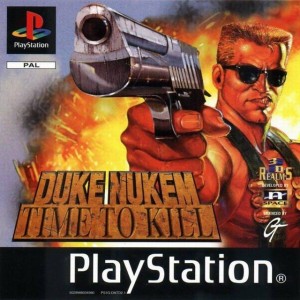 |
Duke’s first console exclusive outing was a third person shooter that picks up not long after Duke Nukem 3D. Duke is on his way to the Bootylicious Strip Club in Downtown Los Angeles when pig cops warp into the street and transform his motorcycle into a girl’s bicycle. After eliminating the swine threat, Duke discovers that a new alien threat is messing with the time line, attempting to take over Earth before Duke was around to stop them. Thus begins a time travelling, ass kicking adventure.
Time to Kill draws considerable influence from Tomb Raider, given that the Croft franchise was one of the dominant action games on the PlayStation at the time. Duke’s game features much more exciting action, but doesn’t quite have the challenging puzzles of Eidos’ games. That said, Time to Kill’s action doesn’t play out at the pace of Duke Nukem 3D – shooting without the zoomed aiming system is often futile, but using the zoomed aim leads to Duke standing still. There is also a great deal more exploring, even when compared to the more search-heavy levels in later parts of Duke 3D.
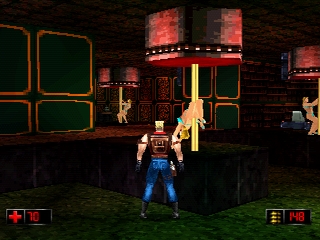 |
 |
The Current Day Los Angeles level functions as a hub world and Duke’s home base. Duke travels to the American West, Ancient Rome and Medieval Europe, encountering a variety of aliens and pig cops dressed in era-appropriate costumes. Of course, you get to take them out with era-appropriate weapons, from your standard pistols and shotguns to unique items like the Holy Hand Grenade. Duke’s personality is in full effect too, with plenty of one liners courtesy of Jon St. John, who reprises his role from Duke 3D.
Time to Kill was the most successful Duke Nukem console title. The game received a heavy marketing push from GT Interactive, and that combined with goodwill from Duke Nukem 3D and heavy anticipation for the recently revealed Duke Nukem Forever made the title appealing to gamers. Time to Kill received a Greatest Hits re-release in North America, where it sold an estimated 670,000 units.
Duke Nukem: Zero Hour (1999, Eurocom, Nintendo 64)
 |
 |
Zero Hour is conceptually quite similar to Time to Kill, but a completely separate game. Aliens are attacking Earth again, and the military calls on Duke to lead the counterattack. After battling the aliens on the streets of New York, Duke discovers their real plan – to travel back in time and mess with history so humanity is weaker and prime for takeover. Action takes place in the present day, the Old West, the Victorian Era and a post apocalyptic future.
Whereas Time to Kill was influenced by Tomb Raider, Zero Hour is a straight up third person shooter with little in the way of platforming and puzzles. The game utilises the same control scheme as Turok, with the C-Pad controlling moving and the analogue stick handling aiming. The game is very linear – run down the hallways, blast anything that gets in your way, find the end of the level and repeat as necessary.
 |
 |
Critics enjoyed the more focused action of Zero Hour, but punished the game for its technical deficiencies. The game was a little too ambitious for the ageing Nintendo 64 hardware – a problem exacerbated if one attempted to play the game with the high resolution mode provided by using the RAM expansion pack. The game was particularly unforgiving with regards to dying during a level; there were no checkpoints or quick save options – death means starting the level over. Some levels in the game last over an hour, which makes cheap deaths particularly frustrating.
GT Interactive did not promote Zero Hour as heavily as Time to Kill, but it still had a generous advertising campaign. It did not perform as well as Time to Kill or even Duke Nukem 64, selling a more modest 177,000 units in the US, and less than that in Europe.
Duke Nukem (1999, Torus Games, Game Boy Color)

Duke had his first handheld outing on the Game.com, but when that failed to garner much success, GT Interactive took the character to a more popular format. Australian developer Torus Games was enlisted with the task of bringing Duke to the Game Boy Color.
The game is something of an adaptation of Duke Nukem II with some of the character sensibilities from Duke Nukem 3D thrown into the mix. It takes a few notes from the Metal Slug series at times, giving Duke access to vehicles with more powerful weaponry.
Duke Nukem is a little more basic than the other platforming offerings on the Game Boy Color. Some critics felt that the game’s visual presentation and sound were primitive, even by the standards of the platform. However, others felt that the game was more or less a faithful reproduction of Duke’s 2D origins.
Duke Nukem: Land of the Babes (2000, n-Space, PlayStation)
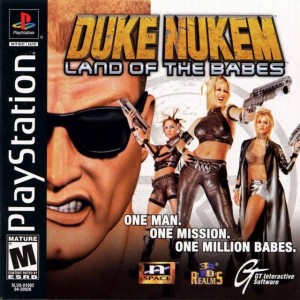 |
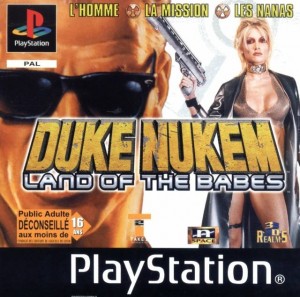 |
Land of the Babes is a direct sequel to Time to Kill, involving Duke travelling through time (yet again). This time, Duke is sent forward in time to a dystopian future where aliens killed all of the men in the world, and the remaining women formed a resistance movement called the Unified Babe Resistance. The UBR sent for Duke to be brought to the future to help them finish the war against the aliens.
Gameplay is virtually identical to Time to Kill’s mix of gunplay and Tomb Raider-inspired light platforming and puzzle action. There is a little more variety in your level objectives, but the core action is more or less the same. The controls are still rather annoying to adjust to – Time to Kill hit in that awkward period where the Dual Shock wasn’t standard issue, but there was no excuse by this point.
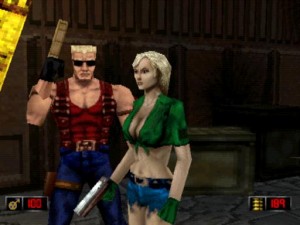 |
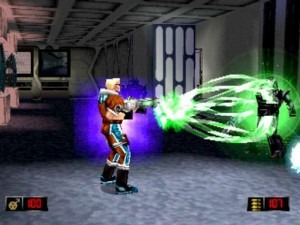 |
Critical opinion on Land of the Babes was divisive. Some felt that the game was a decent but unremarkable sequel, while others felt the game was archaic and unfunny. The game was the least successful of Duke’s home console outings, selling just 37,000 copies in North America.
Land of the Babes was originally planned to be released under the title Planet of the Babes. It is understood that the producers of the Tim Burton-directed Planet of the Apes remake leant on GT Interactive and 3D Realms to change the title. Television commercials and print ads bearing the original name were produced.
Duke Nukem: Manhattan Project (2002, Sunstorm Interactive, Windows)
 Sunstorm Interactive had some success producing expansions for Duke Nukem 3D, so they approached 3D Realms with the idea of producing a new 2D shooter based on the Duke franchise in 2002. Manhattan Project would bring together the Duke personality from Duke 3D with the 2D platforming gameplay of the first two Duke games, albeit updated to more modern standards.
Sunstorm Interactive had some success producing expansions for Duke Nukem 3D, so they approached 3D Realms with the idea of producing a new 2D shooter based on the Duke franchise in 2002. Manhattan Project would bring together the Duke personality from Duke 3D with the 2D platforming gameplay of the first two Duke games, albeit updated to more modern standards.
Manhattan Project pits Duke up against Mech Morphix, an ersatz Dr. Proton who is using a radioactive slime called G.L.O.P.P. to mutate creatures into monsters in order to take over Manhattan Island.
Character models and levels are full 3D, but the action is limited to a 2D plane. The game follows a fairly standardised formula – Duke needs to disarm a G.L.O.P.P. bomb attached to a babe and find a key card in order to finish each level (of which there are 24). Players can make their own levels using the editor supplied with the game. Duke has access to a sizeable armory to get the job done, but only three of the weapons (shotgun, RPG and the assault rifle) are actually useful.
Released at a budget price, Manhattan Project won praise from critics and fans upon its original release. The game’s copyright was caught up in bankruptcy proceedings for a number of years after original publisher ARUSH went bust. 3D Realms managed to get its hands on the copyright and produce a version for the Xbox Live Arcade. This release was not well regarded.
Duke Nukem Advance (2002, Torus Games, Game Boy Advance)
 A rush of first person shooters hit the Game Boy Advance in its early years, and Duke was right there with them. Upon first glance, Duke Nukem Advance looks like a port-based sequel to Duke Nukem 3D, but the game was built from the ground up on Take 2’s Southpaw engine.
A rush of first person shooters hit the Game Boy Advance in its early years, and Duke was right there with them. Upon first glance, Duke Nukem Advance looks like a port-based sequel to Duke Nukem 3D, but the game was built from the ground up on Take 2’s Southpaw engine.
Duke Nukem Advance has the blond one off on a globetrotting adventure to fight a new alien threat (that’s practically identical to the alien threat from Duke Nukem 3D). Duke discovers that the aliens require certain environmental regulators to live, and goes about trashing them all to save Earth (yet again).
Duke Nukem Advance plays almost identically to Duke Nukem 3D – many of the same weapons and enemies are used. Level design is serviceable, adding in a couple of platforming based challenges and timed escape sequences into the usual FPS mix. The game succeeds from a visual standpoint, pushing the GBA hardware towards its max, and all of the requisite Duke speech samples are present. A four player Deathmatch mode is also thrown in for good measure.
A quality game all around, Duke Nukem Advance was hailed as being the best first person shooter on the Game Boy Advance. Some fans were a little disenchanted by the fact that the game had some self-censorship to squeeze it into a US Teen rating, but otherwise, the game enjoys a respectable legacy.
Duke Nukem Mobile (2004, Machineworks Northwest, Mobile Phones)
Duke Nukem Mobile is the blond one’s first phone based outing. It’s a sort of weird pseudo 3D shooter not unlike a side-scrolling version of Ikari Warriors. The game is quite simple – just walk from left to right, blasting anything that gets in your way until you reach the end of the level. The game looks nice enough, particularly for a mobile phone game from the early 2000 era, but you can’t help but feel that there should be more to it.
 |
 |
Duke Nukem Mobile 3D (2004, Machineworks Northwest, Tapwave Zodiac)
Duke Nukem Mobile 3D applies the gameplay of Duke Nukem 3D to the Tapwave Zodiac and mobile phones with a few technical enhancements. While the game is technically impressive, it is very short and quite difficult to play given the limited control mechanisms provided.
 |
 |
Duke Nukem Mobile II: Bikini Project (2005, Machineworks Northwest, Mobile Phones)
Take Duke Nukem Mobile, add in a jetpack, flamethrower and more babes, and you’ve for Duke Nukem Mobile II. It isn’t exactly rocket science, but it is a reasonably fun little shooter. The graphics have been cleaned up a little, and the game runs a lot smoother. Like the original game, it would have benefited from greater depth of content, but you can’t win them all.
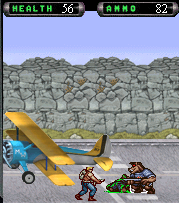 |
 |
Duke Nukem Arena 3D (2007, Machineworks Northwest, Mobile Phones)
Duke Nukem Arena 3D is another adaptation of the Duke Nukem 3D style of first person shooter to cellphones. It combines the single player only Duke Nukem Mobile 3D with a set of online-compatible multiplayer modes for up to four players. The game performs admirably, but the core concept of a first person shooter on a mobile phone is something few are willing to accept.
Duke Nukem: Critical Mass (2011, Nintendo DS)
At E3 2008, Apogee announced the Duke Nukem Trilogy via this utterly hilarious trailer.
The trio of Critical Mass, Proving Grounds and Chain Reaction were meant to launch on the Nintendo DS and PSP in 2009. Due to production delays and numerous other issues not known to the public, only the DS version of Critical Mass has been released.
And boy, is it ever awful.
The game utilises yet another time travel plot in which the EDF loses some agents in the future while trying to monitor Earth’s continued safety. Duke is called on to rescue them.
Critical Mass attempts to recreate the 2.5D platforming action of Manhattan Project on a budget that wouldn’t cover a cup of coffee. The game has the most pathetic looking character models and rigid information you’ll see on the Nintendo DS – and that’s saying something. There is a mix of first and third person levels, but neither is close to anything that could be remotely considered good. Just pretend it doesn’t exist.
Leave a Reply
You must be logged in to post a comment.




